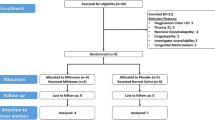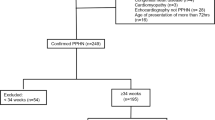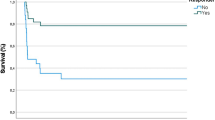Abstract
Objective:
Milrinone has been proposed as an effective treatment for pulmonary hypertension (PH) and right ventricular (RV) dysfunction. We aimed to determine the effect of milrinone therapy on clinical and echocardiography parameters of PH in preterm infants with elevated pulmonary pressures.
Study Design:
A retrospective case review was conducted on infants <32 weeks gestation who received milrinone for the treatment of PH and reduced RV function. Echocardiographic data were collected before and after treatment with milrinone, and serial clinical parameters were recorded over a 72h period.
Result:
Seven infants met the inclusion criteria with a median gestation and birth weight of 27.3 weeks and 1140 g, respectively. Four infants had a diagnosis of pulmonary hypoplasia with PH, and three infants were recipients in twin-to-twin transfusion syndrome who also developed PH. Nitric oxide was used in six infants before commencement of milrinone. Milrinone was commenced at a dose of 0.33 μg kg−1 min−1 to 0.5 μg kg−1 min−1 and continued for a median duration of 70 h. Use of milrinone was associated with a fall in oxygenation index and inhaled nitric oxide dose. Following an initial fall in blood pressure over the first 6 h, there was an increase in blood pressure over the subsequent 72 h. Echocardiographic data demonstrated an increase in indicators of myocardial performance and PH. One infant died before discharge.
Conclusion:
This case series suggests that milrinone may be a useful therapy for premature infants with echocardiography findings of PH and/or RH dysfunction. This data support the need for a randomised control trial to confirm its efficacy.
This is a preview of subscription content, access via your institution
Access options
Subscribe to this journal
Receive 12 print issues and online access
$259.00 per year
only $21.58 per issue
Buy this article
- Purchase on Springer Link
- Instant access to full article PDF
Prices may be subject to local taxes which are calculated during checkout


Similar content being viewed by others
References
Kilbride HW, Thibeault DW . Neonatal complications of preterm premature rupture of membranes. Pathophysiology and management. Clin Perinatol 2001; 28 (4): 761–85.
Takahashi H, Takahashi S, Tsukamoto K, Ito Y, Nakamura T, Hayashi S et al. Persistent pulmonary hypertension of the newborn in twin-twin transfusion syndrome following fetoscopic laser surgery. J Matern fetal Neonatal Med 2012; 25 (5): 543–5.
Delsing B, Lopriore E, Blom N, Te Pas AB, Vandenbussche FP, Walther FJ . Risk of persistent pulmonary hypertension of the neonate in twin-to-twin transfusion syndrome. Neonatology 2007; 92 (2): 134–8.
Shah DM, Kluckow M . Early functional echocardiogram and inhaled nitric oxide: usefulness in managing neonates born following extreme preterm premature rupture of membranes (PPROM. J Paediatr Child Health 2011; 47 (6): 340–5.
Zhao S, Deng YB, Chen XL, Liu R . Assessment of right ventricular function in recipient twin of twin to twin transfusion syndrome with speckle tracking echocardiography. Ultrasound Med Biol 2012; 38 (9): 1502–7.
Barrington KJ, Finer N . Inhaled nitric oxide for respiratory failure in preterm infants. Cochrane Database Syst Rev 2010; (12): CD000509.
Danhaive O, Margossian R, Geva T, Kourembanas S . Pulmonary hypertension and right ventricular dysfunction in growth-restricted, extremely low birth weight neonates. J Perinatol 2005; 25 (7): 495–9.
McNamara PJ, Shivananda SP, Sahni M, Freeman D, Taddio A . Pharmacology of milrinone in neonates with persistent pulmonary hypertension of the newborn and suboptimal response to inhaled nitric oxide. Pediatr Crit Care Med 2013; 14 (1): 74–84.
El-Khuffash A, Herbozo C, Jain A, Lapointe A, McNamara PJ . Targeted neonatal echocardiography (TnECHO service in a Canadian neonatal intensive care unit: a 4-year experience. J Perinatol 2013; 33 (9): 687–90.
El-Khuffash AF, McNamara PJ . Neonatologist-performed functional echocardiography in the neonatal intensive care unit. Semin Fetal Neonatal Med 2010; 16 (1): 50–60.
Yared K, Noseworthy P, Weyman AE, McCabe E, Picard MH, Baggish AL . Pulmonary artery acceleration time provides an accurate estimate of systolic pulmonary arterial pressure during transthoracic echocardiography. J Am Soc Echocardiogr 2011; 24 (6): 687–92.
Geary C, Whitsett J . Inhaled nitric oxide for oligohydramnios-induced pulmonary hypoplasia: a report of two cases and review of the literature. J Perinatol 2002; 22 (1): 82–5.
Chock VY, Van Meurs KP, Hintz SR, Ehrenkranz RA, Lemons JA, Kendrick DE et al. Inhaled nitric oxide for preterm premature rupture of membranes, oligohydramnios, and pulmonary hypoplasia. Am J Perinatol 2009; 26 (4): 317–22.
Moenkemeyer F, Patel N . Right ventricular diastolic function measured by tissue Doppler imaging predicts early outcome in congenital diaphragmatic hernia. Pediatr Crit Care Med 2013; 15 (1): 49–55.
Rychik J, Zeng S, Bebbington M, Szwast A, Quartermain M, Natarajan S et al. Speckle tracking-derived myocardial tissue deformation imaging in twin-twin transfusion syndrome: differences in strain and strain rate between donor and recipient twins. Fetal Diagn Ther 2012; 32 (1-2): 131–7.
Herberg U, Bolay J, Graeve P, Hecher K, Bartmann P, Breuer J . Intertwin cardiac status at 10-year follow-up after intrauterine laser coagulation therapy of severe twin-twin transfusion syndrome: comparison of donor, recipient and normal values. Arch Dis Child Fetal Neonatal Ed 2014; 99 (5): F380–5.
Herberg U, Gross W, Bartmann P, Banek CS, Hecher K, Breuer J . Long term cardiac follow up of severe twin to twin transfusion syndrome after intrauterine laser coagulation. Heart 2006; 92 (1): 95–100.
Keravis T, Lugnier C . Cyclic nucleotide phosphodiesterases (PDE and peptide motifs. Curr Pharm Des 2010; 16 (9): 1114–25.
Silver PJ, Harris AL, Canniff PC, Lepore RE, Bentley RG, Hamel LT et al. Phosphodiesterase isozyme inhibition, activation of the cAMP system, and positive inotropy mediated by milrinone in isolated guinea pig cardiac muscle. J Cardiovasc Pharmacol 1989; 13 (4): 530–40.
LeJemtel TH, Scortichini D, Levitt B, Sonnenblick EH . Effects of phosphodiesterase inhibition on skeletal muscle vasculature. Am J Cardiol 1989; 63 (2): 27A–30A.
Lakshminrusimha S, Porta NF, Farrow KN, Chen B, Gugino SF, Kumar VH et al. Milrinone enhances relaxation to prostacyclin and iloprost in pulmonary arteries isolated from lambs with persistent pulmonary hypertension of the newborn. Pediatr Crit Care Med 2009; 10 (1): 106–12.
Rashid N, Morin FC 3rd, Swartz DD, Ryan RM, Wynn KA, Wang H et al. Effects of prostacyclin and milrinone on pulmonary hemodynamics in newborn lambs with persistent pulmonary hypertension induced by ductal ligation. Pediatr Res 2006; 60 (5): 624–9.
Khazin V, Kaufman Y, Zabeeda D, Medalion B, Sasson L, Schachner A et al. Milrinone and nitric oxide: combined effect on pulmonary artery pressures after cardiopulmonary bypass in children. J Cardiothorac Vasc Anesth 2004; 18 (2): 156–9.
Deb B, Bradford K, Pearl RG . Additive effects of inhaled nitric oxide and intravenous milrinone in experimental pulmonary hypertension. Critic Care Med 2000; 28 (3): 795–9.
Hoffman TM, Wernovsky G, Atz AM, Kulik TJ, Nelson DP, Chang AC et al. Efficacy and safety of milrinone in preventing low cardiac output syndrome in infants and children after corrective surgery for congenital heart disease. Circulation 2003; 107 (7): 996–1002.
Jain A, Sahni M, El-Khuffash A, Khadawardi E, Sehgal A, McNamara PJ . Use of targeted neonatal echocardiography to prevent postoperative cardiorespiratory instability after patent ductus arteriosus ligation. J Pediatr 2012; 160 (4): 584–9.
El-Khuffash AF, Jain A, Weisz D, Mertens L, McNamara PJ . Assessment and treatment of post patent ductus arteriosus ligation syndrome. J Pediatr 2014; 165 (1): 46–52.e1.
McNamara PJ, Laique F, Muang-In S, Whyte HE . Milrinone improves oxygenation in neonates with severe persistent pulmonary hypertension of the newborn. J Crit Care 2006; 21 (2): 217–22.
Bassler D, Choong K, McNamara P, Kirpalani H . Neonatal persistent pulmonary hypertension treated with milrinone: four case reports. Biol Neonate 2006; 89 (1): 1–5.
Danhaive O, Margossian R, Geva T, Kourembanas S . Pulmonary hypertension and right ventricular dysfunction in growth-restricted, extremely low birth weight neonates. J Perinatol 2005; 25 (7): 495–9.
Paradisis M, Evans N, Kluckow M, Osborn D . Randomized trial of milrinone versus placebo for prevention of low systemic blood flow in very preterm infants. J Pediatr 2009; 154 (2): 189–95.
Murase M, Morisawa T, Ishida A . Serial assessment of left-ventricular function using tissue Doppler imaging in premature infants within 7 days of life. Pediatr Cardiol 2013; 34 (6): 1491–8.
Lee A, Nestaas E, Liestol K, Brunvand L, Lindemann R, Fugelseth D . Tissue Doppler imaging in very preterm infants during the first 24 h of life: an observational study. Arch Dis Childh Fetal Neonatal Ed 2014; 99 (1): F64–9.
Ciccone MM, Scicchitano P, Zito A, Gesualdo M, Sassara M, Calderoni G et al. Different functional cardiac characteristics observed in term/preterm neonates by echocardiography and tissue doppler imaging. Early Hum Dev 2011; 87 (8): 555–8.
Author information
Authors and Affiliations
Corresponding author
Ethics declarations
Competing interests
The authors declare no conflict of interest.
Rights and permissions
About this article
Cite this article
James, A., Bee, C., Corcoran, J. et al. Treatment of premature infants with pulmonary hypertension and right ventricular dysfunction with milrinone: a case series. J Perinatol 35, 268–273 (2015). https://doi.org/10.1038/jp.2014.208
Received:
Revised:
Accepted:
Published:
Issue Date:
DOI: https://doi.org/10.1038/jp.2014.208
This article is cited by
-
Response to pulmonary vasodilators in infants with congenital diaphragmatic hernia
Pediatric Surgery International (2018)
-
Controversies in the identification and management of acute pulmonary hypertension in preterm neonates
Pediatric Research (2017)
-
Management of hypoxemic respiratory failure and pulmonary hypertension in preterm infants
Journal of Perinatology (2016)
-
Persistent pulmonary hypertension of the newborn
Maternal Health, Neonatology and Perinatology (2015)



